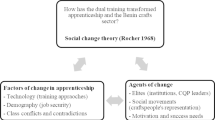Abstract
The term craftsmanship is associated with pre-industrial craft work with inferences to skilled artisanal manufacture of bespoke products. Apprenticeship learning is often perceived to be synonymous with learning craftsmanship. How then is the trait of craftsmanship through attainment of specific artisanal approaches conveyed and learnt through apprenticeship? This article presents and discusses processes imposed on and utilised by apprentices to attain precepts of artisanal approaches. The dispositional and skill elements of craftsmanship are proposed to be adopted through engagement with and development of craft and workplace specific approaches to contend with aspects of Pye’s (1968) conceptualisation of ‘workmanship of risk’ or the article’s proposed term of ‘artisanal approach of risk’.
Similar content being viewed by others
References
Ainley, P. (1993). Class and skill: divisions of knowledge and labour. New York: Cassell.
Anderson, C. (2012). Makers: the new industrial revolution. New York, NY: Crown Publishing.
Barsalou, L. W. (2008). Grounded cognition. Annual Review of Psychology, 59, 617–645.
Billett, S. (2006). Constituting the workplace curriculum. Journal of Curriculum Studies, 36(1), 31–48.
Billett, S. (2011). Vocational education: purposes, traditions and prospects. Dordrecht, Netherlands: Springer.
Billett, S. (2014). Mimetic learning in the circumstances of professional practice. In A. Littlejohn & A. Fargaryan (Eds.), Technology-enhanced professional learning: processes, practices and tools. New York, NY: Routledge.
Billett, S., & Choy, S. (2013). Learning through work: emerging perspectives and new challenges. Journal of Workplace Learning, 25(4), 264–276.
Chan, S. (2011). Belonging to a workplace, becoming and being a baker: The role and processes of apprenticeship. Unpublished PhD thesis. Griffith University.
Chan, S. (2013). Learning a trade: Becoming a trades person through apprenticeship. Ako Aotearoa Southern Hub. https://akoaotearoa.ac.nz/ako-hub/ako-aotearoa-southern-hub/resources/pages/learning-trade-becoming-trades-person-through-apprenticeship
Collier, D. (2011). Understanding process tracing. PS: Political Science and Politics, 44(4), 823–830.
Corson, D. (1985). Education for work: reflections towards a theory of vocational education. International Review of Education, 31(3), 283–302.
Cran, D. J. (1994). Towards validation of the service orientation construct. The Services Industries Journal, 14(1), 34–44.
Crawford, M. B. (2009). Shop class as soulcraft: an inquiry into the value of work. USA: Penguin.
Fenwick, T., Edwards, R., & Sawchuk, P. (2011). London, UK; New York. NY: Routledge. Emerging approaches to educational research.
Fine, G. A. (2003). Occupational aesthetics: How trade school students learn to cook. In D. Harper & H. M. Lawson (Eds.), The cultural study of work (pp. 74–95). USA: Rowman & Littlefield Pub. Inc.
Fuller, A., & Unwin, L. (2003). Learning as apprentices in the contemporary UK workplace: creating and managing expansive and restrictive participation. Journal of Education and Work, 16(4), 407–426.
Gamble, J. (2001). Modelling the invisible: the pedagogy of craft apprenticeship. Studies in Continuing Education, 23(2), 185–200.
George, A. L., & Bennett, A. (2005). Case studies and theory development in the social sciences. Cambridge, MA. London: MIT Press.
Gherardi, S. (2010). Community of practice or practices of a community? In S. J. Armstrong & C. V. Fukami (Eds.), The SAGE handbook on management, learning, education and development (pp. 514–530). Thousand Oaks, CA: Sage Publications.
Gurung, R. A., Chick, N. L., & Haynie, A. (2009). Exploring signature pedagogies: approaches to teaching disciplinary habits of mind. Sterling, VA: Stylus Publishing.
Guthrie, C. (2007). On learning the research craft: Memoirs of a journeyman researcher. Journal of Research Practice, 3(1), Article M1. Retrieved [26th May 2014], from http://jrp.icaap.org/index.php/jrp/article/view/47/80
Guthrie, J., Guthrie, A., Lawson, R., & Cameron, A. (2006). Farmers’ markets: the small business counter-revolution in food production and retailing. British Food Journal, 108(7), 560–573.
Hodkinson, P., Biesta, G., & James, D. (2008). Understanding learning culturally: overcoming the dualism between social and individual views of learning. Vocations and Learning, 1(1), 27–47.
Johnson, M. (2007). The meaning of the body: Aesthetics of human understanding. Chicago: University of Chicago Press.
Lave, J., & Wenger, E. (1991). Situated learning: legitimate peripheral participation. UK, USA: Cambridge University Press.
Lucas, B., Spencer, E., & Claxton, G. (2012). How to teach vocational education: A theory of vocational pedagogy. City and guilds centre for skill development. London: UK.
MacEachren, Z. (2004). Function and aesthetics: defining craftsmanship. The Journal of Experiential Education, 26(3), 138–151.
Martin, R. C. (2008). Clean code: a handbook of agile software craftsmanship. Upper Saddle River, NJ: Prentice Hall.
Pye, D. (1968). The nature and Art of workmanship. London, UK: Herbert Press.
Schwalbe, M. (2010). In search of craft. Social Psychology Quarterly, 73(2), 107–111.
Sennett, R. (2008). The Craftsman. New Haven, CT: Yale University Press.
van Dreil, J. H., Verloop, N., van Werven, I., & Dekkers, H. (1997). Teachers’ craft knowledge and curriculum innovation in higher engineering education. Higher Education, 34, 105–122.
Vickerstaff, S. A. (2003). Apprenticeships in the ‘golden age’: Were youth transitions really smooth and unproblematic back then? Work, Employment and Society, 17(2), 269–287.
Vickerstaff, S. (2007). ‘I was just the boy around the place’: what made apprenticeships successful? Journal of Vocational Education and Training, 59(3), 331–347.
Author information
Authors and Affiliations
Corresponding author
Rights and permissions
About this article
Cite this article
Chan, S. Crafting an Occupational Identity: Learning the Precepts of Craftsmanship Through Apprenticeship. Vocations and Learning 7, 313–330 (2014). https://doi.org/10.1007/s12186-014-9117-9
Received:
Accepted:
Published:
Issue Date:
DOI: https://doi.org/10.1007/s12186-014-9117-9




